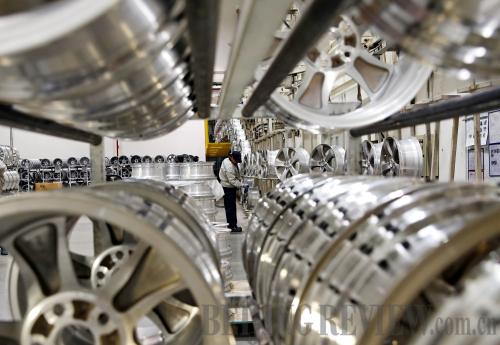|
 |
|
MASS PRODUCTION: A worker checks wheels at the assembly line of CITIC Dicastal Wheel Manufacturing Co. Ltd., a leading global manufacturer of aluminum wheels, in Qinhuangdao, north China's Hebei Province (YANG SHIYAO) |
Thirty-five years after the United States and China established formal diplomatic ties, could the world have imagined that a group of leading diplomats and financial leaders would ring the opening bell of the New York Stock Exchange (NYSE), celebrating the unprecedented economic growth and trajectory of the Chinese economy and its importance to the United States? The past three decades have been truly astounding to China watchers, and leading forecasters project a continued growth rate of 7 percent to 8 percent this year.
A "dual-track" approach of transitional subsidies and market liberalization has "allowed China to achieve, on the average, 9.7 percent growth rate continuously for 35 years; it's a miracle in human history," said Justin Yifu Lin, former World Bank senior vice president and chief economist, in a keynote address at the National Committee on U.S.-China Relations' 2014 economic forecast event on January 6. "We have never observed such a long sustained period of high growth in any country at any time in any part of the world."
NYSE Euronext CEO Duncan Niederauer welcomed guests, committee representatives and members of the China Center for Economic Research (CCER) to the economic forecast, saying "2013 was a pretty exciting year and I'm sure 2014 will be more of the same," adding that investor interest in the offerings of Chinese listings on the NYSE is on the rebound.
To note the anniversary of the establishment of formal ties, and the fifth annual forecast event, Stephen A. Orlins, President of the National Committee on U.S.-China Relations, joined China's UN representative Liu Jieyi, Chinese Ambassador to the United States Cui Tiankai and Lin to ring the opening bell for the NYSE.
Roadmap for growth
"It's fair to say that none of us foresaw what China's economic development would be [like] and that China would be one of the defining forces of the 21st century," said Orlins. "Today, 35 years later [after the establishment of diplomatic relations], China stands at another crossroads. The November communiqué of the Third Plenary Session of the 18th Central Committee of the Communist Party of China has laid out an extraordinary reform agenda. The implementation of that agenda will determine the future of China and the future of the U.S.-China relationship."
The third plenary session was ambitious and visionary, said Yao Yang, Dean of the National School of Development (NSD) at Peking University and Director of the CCER. The world is changing fast, and China is changing at an even greater pace, from a closed country to the most important contributor to global economic growth.
The communiqué is comprehensive, with deeper reforms in political and social realms in addition to economic policy, said Qin Xiao, Chairman of the Boyuan Foundation and former Chairman of China Merchants Group.
"We cannot rely purely on economic reform for social progress," Qin said.
Over the next seven years, two distinctive features will emerge to affect investment opportunities in China, predicted Huang Yiping, Deputy Dean of the NSD. For one, reform will be driven by top authorities, rather than the traditional "bottom-up" approach—a policy that became known as "crossing the river by touching the stones." Reforms to the farming system in the 1980s, for example, were initiated by farmers themselves before being adopted at large by the state.
Now, there "are no more stones to be touched," Huang said, in areas such as market-oriented reforms, and a top-level authority is important. Reform also faces increasing resistance from special interest groups, he said, and strong backing from the national leadership will help to overcome the growing pains that change naturally incurs.
"The second very important feature of the reform program is to complete the transition of the Chinese economy to a market system. The single most important sentence in the whole document, to me, is the following—Wherever the market mechanism works in allocating resources, the government should never intervene," Huang said. "That really is a fundamental change in the approach of the government and the market should work together. Obviously, that does not mean the government would no longer be proactive. It will continue to play an active role in overcoming market failures."
|
